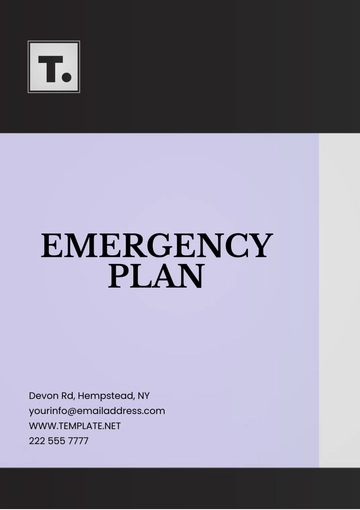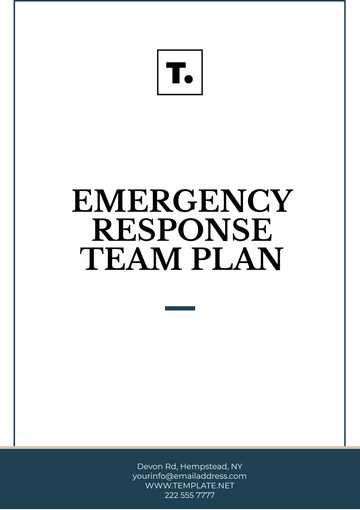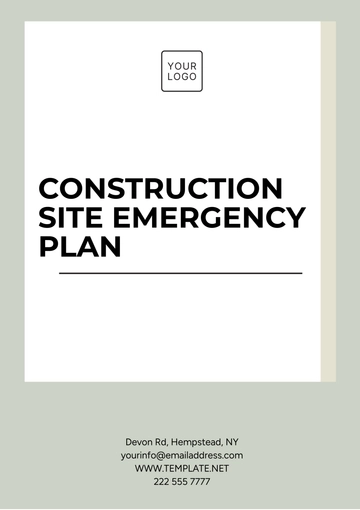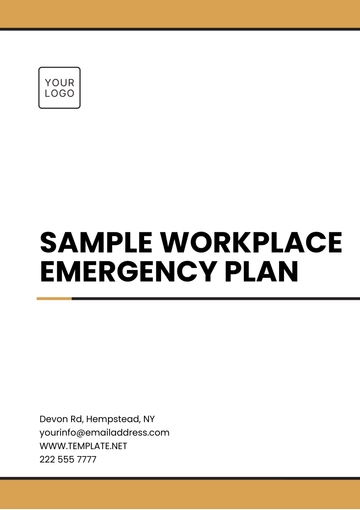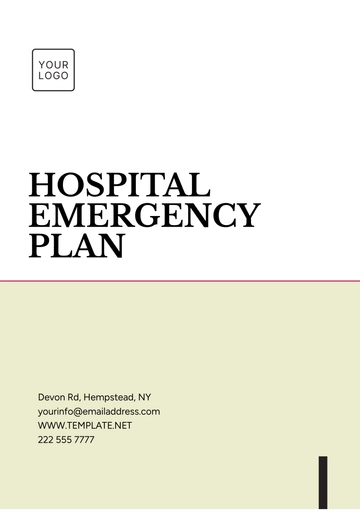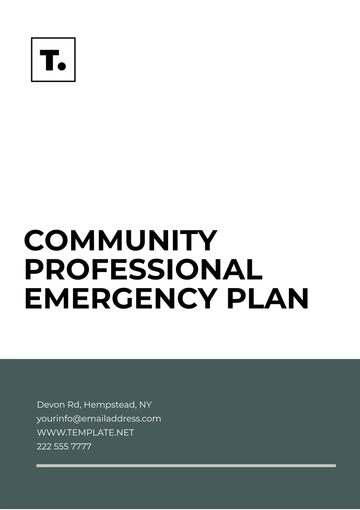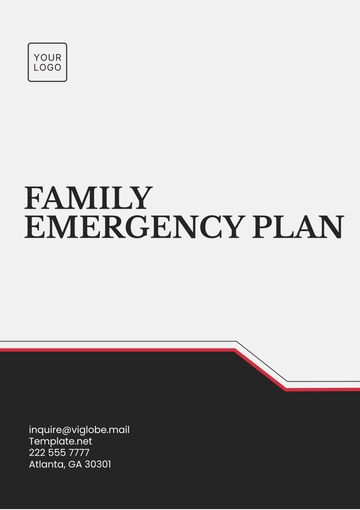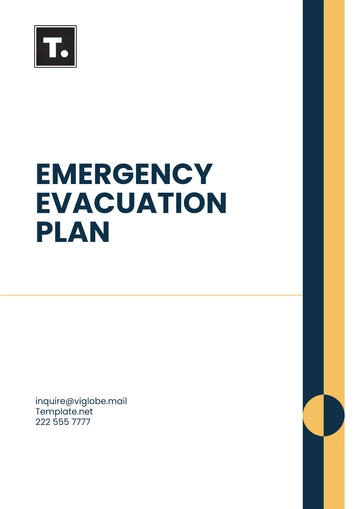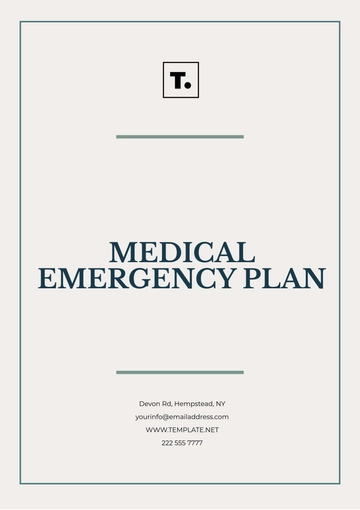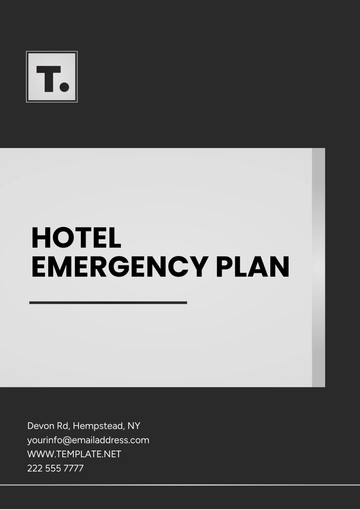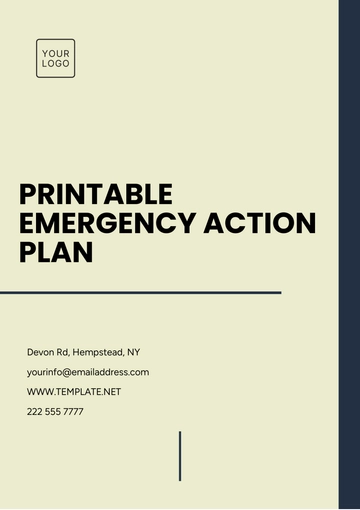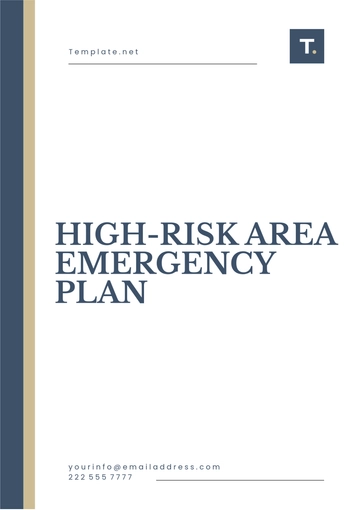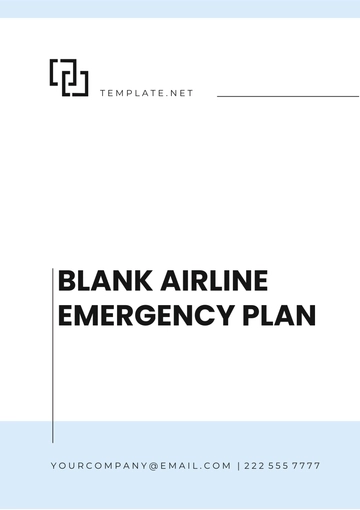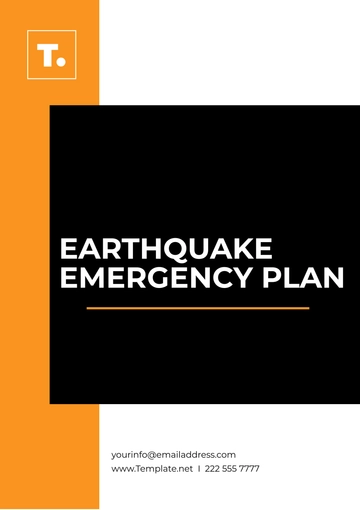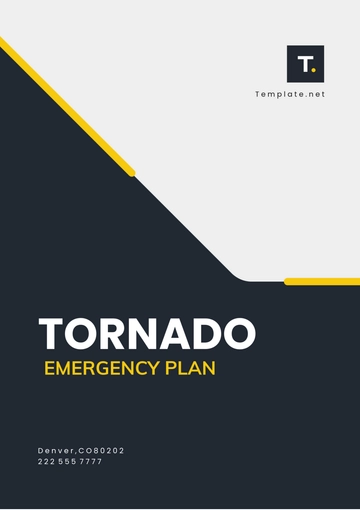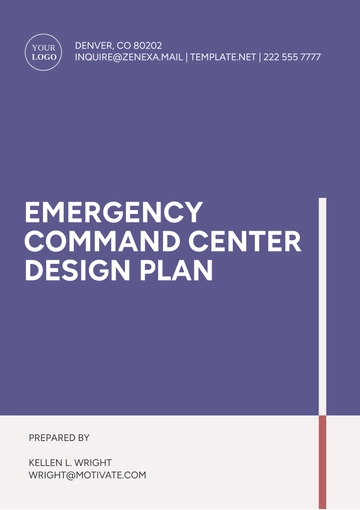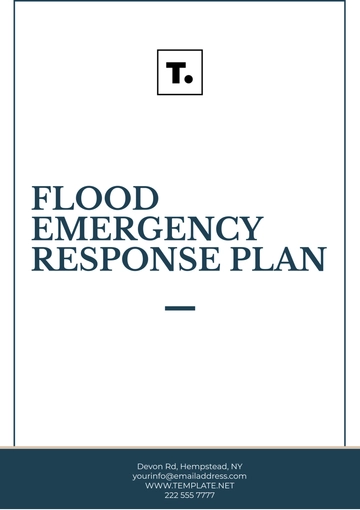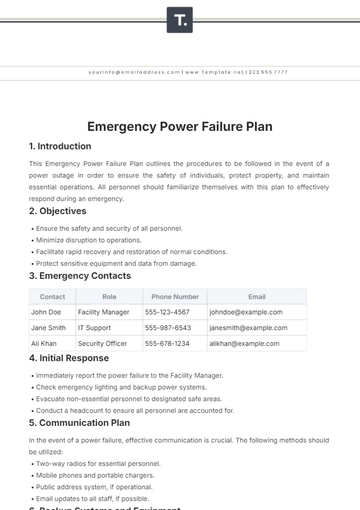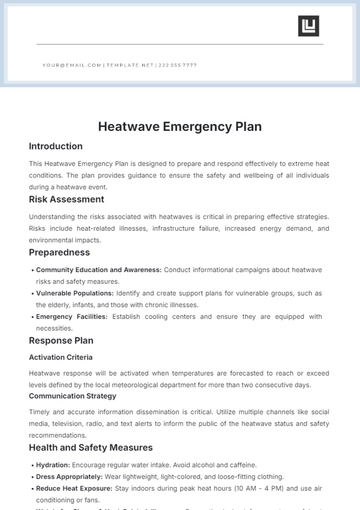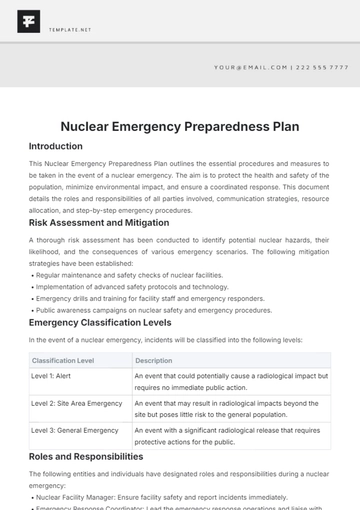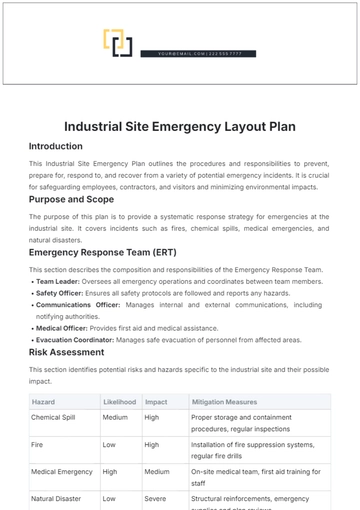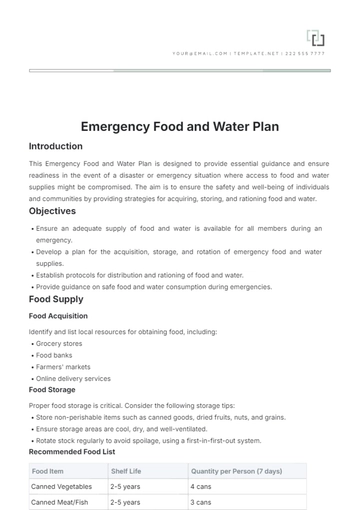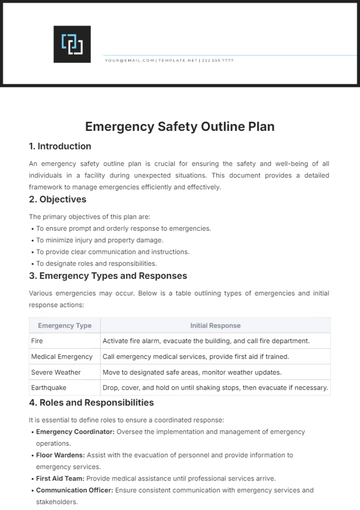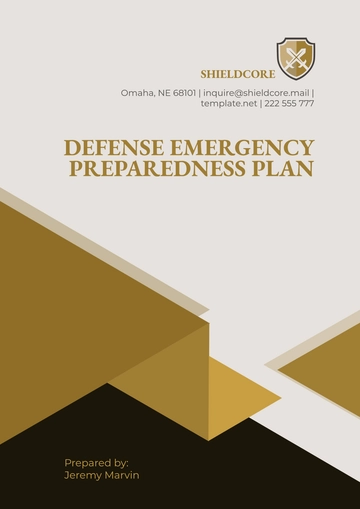Free Cleaning Services Facility Emergency Response Plan

I. Introduction
A. Purpose
The primary purpose of this Emergency Response Plan is to establish a comprehensive and effective protocol to address various potential emergencies within [Your Company Name]. This plan is designed to minimize the impact of emergencies on our employees, clients, and operations, ensuring a coordinated and efficient response that prioritizes safety and property protection.
B. Scope
This plan applies to all areas of operation within our facility, including office spaces, cleaning supply storage areas, and any other spaces utilized in the course of our cleaning services. It covers the actions to be taken by our employees and emergency response team in the event of an emergency, such as a fire, natural disaster, chemical spill, or medical incident.
II. Emergency Contact Information
Effective communication is critical in an emergency. Below is a table of roles within our organization and external services to be contacted in case of an emergency. The specific contact information for each role will be maintained in an accessible and regularly updated format.
Role | Contact |
Facility Manager | |
Safety Officer | |
Local Fire Department | |
Police Department | |
Emergency Medical Services | |
Nearest Hospital | |
Poison Control Center |
III. Facility Information
Our facility encompasses various areas, including offices, storage spaces for cleaning supplies, and common areas such as break rooms and restrooms. The layout of the facility is designed with safety in mind, featuring clear access points and emergency exits that are well-marked and free of obstructions. Detailed maps of the facility's layout, highlighting emergency exits and routes, are posted in strategic locations throughout the building to ensure everyone is aware of how to exit the building quickly and safely in the event of an emergency.
Fire extinguishers and first aid kits are crucial components of our emergency preparedness. Fire extinguishers are located at key points throughout the facility, including in the kitchen area, near electrical equipment, and in storage areas where flammable materials are kept. First aid kits are readily accessible in the break room, near the main office area, and in the storage room. The locations of all fire extinguishers and first aid kits are clearly marked and included in the facility maps. Regular inspections are conducted to ensure that these emergency tools are in good working condition and fully stocked.
IV. Emergency Response Team
Our Emergency Response Team is a specialized group within our facility, tasked with leading and coordinating the response to any emergency situation. Team members are trained in various aspects of emergency response, including evacuation procedures, first aid, and emergency equipment use. The roles within the Emergency Response Team are defined to ensure a comprehensive approach to managing emergencies, with responsibilities ranging from immediate action to communication with external emergency services.
Role | Responsibilities |
Team Leader | Coordinates all emergency response activities; primary decision-maker during emergencies. |
Safety Officer | Assesses hazards; ensures implementation of safety protocols; liaises with external emergency services. |
Communication Officer | Manages internal and external communication; ensures all team members are informed. |
First Aid Officer | Provides first aid and medical assistance; manages first aid supplies. |
Evacuation Coordinator | Leads evacuation procedures; ensures safe and orderly evacuation of all |
V. Types of Emergencies
Various emergencies can occur within a cleaning services facility, each requiring specific response procedures to ensure the safety and well-being of all individuals present. Below is a table outlining common types of emergencies and the corresponding response procedures for each.
Type | Response Procedures |
Fire |
|
Chemical Spill |
|
Natural Disaster |
|
Medical Emergency |
|
Power Outage |
|
Intruder/ Security Threat |
|
VI. Evacuation Procedures
A. Criteria
Deciding when to evacuate the facility is critical and depends on various factors that ensure the safety of all individuals. Evacuation is initiated under the following criteria:
Immediate threat to life or health, such as a fire or gas leak.
Orders from emergency services or the Emergency Response Team.
Structural damage to the facility that poses imminent danger.
External conditions that make staying inside unsafe.
B. Evacuation Routes and Assembly Points
Our facility has designated evacuation routes and assembly points to ensure that all individuals can exit the building quickly and safely. Evacuation maps are posted throughout the facility, showing the nearest exits from any location. These routes are checked regularly to ensure they are clear of obstructions. Assembly points are located a safe distance from the building, allowing for the headcount of all personnel. Each department has a designated area at the assembly point to facilitate an organized and efficient evacuation process.
VII. Training and Drills
Regular training and drills are essential for preparing our employees to respond effectively in an emergency. This schedule ensures that everyone is familiar with the Emergency Response Plan and their roles within it.
Program Topic | Frequency | Duration |
Emergency Response Plan Overview | Annually | 1 hour |
Evacuation Drill | Bi-annually | 1 hour |
First Aid Training | Annually | 4 hours |
Fire Extinguisher Training | Annually | 2 hours |
Communication in Emergencies | Annually | 1 hour |
VIII. Post-Emergency Recovery
After an emergency, assessing the situation and reporting the damage is crucial for a swift recovery and resumption of normal operations. A designated team will evaluate the facility for structural damage, equipment functionality, and overall safety. A report detailing the findings and any necessary repairs will be compiled. This process ensures a safe environment for our employees and clients before resuming operations. Additionally, we provide support and resources for employees affected by the emergency to aid in their recovery.
IX. Review and Update of the Plan
The Emergency Response Plan is a living document that requires regular reviews and updates to remain effective. It will be formally reviewed and updated annually or more frequently if significant changes occur in our operations, facility layout, or after an emergency event. This review process includes feedback from employees, lessons learned from drills and actual emergencies, and any new best practices or regulatory requirements. By maintaining a current and comprehensive plan, we ensure our preparedness for future emergencies.
- 100% Customizable, free editor
- Access 1 Million+ Templates, photo’s & graphics
- Download or share as a template
- Click and replace photos, graphics, text, backgrounds
- Resize, crop, AI write & more
- Access advanced editor
Ensure rapid and organized response to emergencies with the Cleaning Services Facility Emergency Response Plan Template from Template.net. This template, both editable and customizable, provides a detailed framework to protect your staff and clients efficiently. Tailor it to your needs in our AI Editor tool, making it an indispensable asset for your facility's safety preparedness.
You may also like
- Finance Plan
- Construction Plan
- Sales Plan
- Development Plan
- Career Plan
- Budget Plan
- HR Plan
- Education Plan
- Transition Plan
- Work Plan
- Training Plan
- Communication Plan
- Operation Plan
- Health And Safety Plan
- Strategy Plan
- Professional Development Plan
- Advertising Plan
- Risk Management Plan
- Restaurant Plan
- School Plan
- Nursing Home Patient Care Plan
- Nursing Care Plan
- Plan Event
- Startup Plan
- Social Media Plan
- Staffing Plan
- Annual Plan
- Content Plan
- Payment Plan
- Implementation Plan
- Hotel Plan
- Workout Plan
- Accounting Plan
- Campaign Plan
- Essay Plan
- 30 60 90 Day Plan
- Research Plan
- Recruitment Plan
- 90 Day Plan
- Quarterly Plan
- Emergency Plan
- 5 Year Plan
- Gym Plan
- Personal Plan
- IT and Software Plan
- Treatment Plan
- Real Estate Plan
- Law Firm Plan
- Healthcare Plan
- Improvement Plan
- Media Plan
- 5 Year Business Plan
- Learning Plan
- Marketing Campaign Plan
- Travel Agency Plan
- Cleaning Services Plan
- Interior Design Plan
- Performance Plan
- PR Plan
- Birth Plan
- Life Plan
- SEO Plan
- Disaster Recovery Plan
- Continuity Plan
- Launch Plan
- Legal Plan
- Behavior Plan
- Performance Improvement Plan
- Salon Plan
- Security Plan
- Security Management Plan
- Employee Development Plan
- Quality Plan
- Service Improvement Plan
- Growth Plan
- Incident Response Plan
- Basketball Plan
- Emergency Action Plan
- Product Launch Plan
- Spa Plan
- Employee Training Plan
- Data Analysis Plan
- Employee Action Plan
- Territory Plan
- Audit Plan
- Classroom Plan
- Activity Plan
- Parenting Plan
- Care Plan
- Project Execution Plan
- Exercise Plan
- Internship Plan
- Software Development Plan
- Continuous Improvement Plan
- Leave Plan
- 90 Day Sales Plan
- Advertising Agency Plan
- Employee Transition Plan
- Smart Action Plan
- Workplace Safety Plan
- Behavior Change Plan
- Contingency Plan
- Continuity of Operations Plan
- Health Plan
- Quality Control Plan
- Self Plan
- Sports Development Plan
- Change Management Plan
- Ecommerce Plan
- Personal Financial Plan
- Process Improvement Plan
- 30-60-90 Day Sales Plan
- Crisis Management Plan
- Engagement Plan
- Execution Plan
- Pandemic Plan
- Quality Assurance Plan
- Service Continuity Plan
- Agile Project Plan
- Fundraising Plan
- Job Transition Plan
- Asset Maintenance Plan
- Maintenance Plan
- Software Test Plan
- Staff Training and Development Plan
- 3 Year Plan
- Brand Activation Plan
- Release Plan
- Resource Plan
- Risk Mitigation Plan
- Teacher Plan
- 30 60 90 Day Plan for New Manager
- Food Safety Plan
- Food Truck Plan
- Hiring Plan
- Quality Management Plan
- Wellness Plan
- Behavior Intervention Plan
- Bonus Plan
- Investment Plan
- Maternity Leave Plan
- Pandemic Response Plan
- Succession Planning
- Coaching Plan
- Configuration Management Plan
- Remote Work Plan
- Self Care Plan
- Teaching Plan
- 100-Day Plan
- HACCP Plan
- Student Plan
- Sustainability Plan
- 30 60 90 Day Plan for Interview
- Access Plan
- Site Specific Safety Plan
